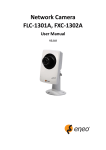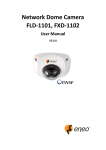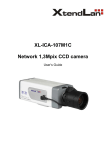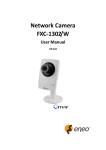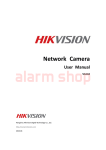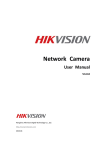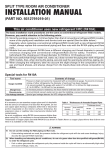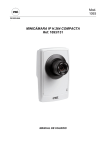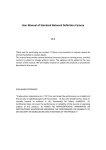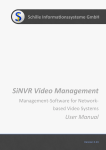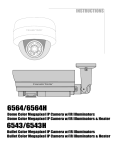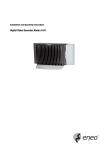Download Network Camera FXC-1201M
Transcript
Network Camera FXC‐1201M User Manual V3.0.0 1 User Manual of Network Camera Safety Instructions • Read these safety instructions and the operation manual first before you install and commission the camera. • Keep the manual in a safe place for later reference. • Protect your camera from contamination with water and humidity to prevent it from permanent damage. Never switch the camera on when it gets wet. Have it checked at an authorized service center in this case. • Never operate the camera outside of the specifications as this may prevent the camera functioning. • Do not operate the cameras beyond their specified temperature, humidity or power ratings. Operate the camera only at a temperature range of ‐10°C to +50°C and at a humidity of max. 90%. • To disconnect the power cord of the unit, pull it out by the plug. Never pull the cord itself. • Pay attention when laying the connection cable and observe that the cable is not subject to heavy loads, kinks, or damage and no moisture can get in. • The warranty becomes void if repairs are undertaken by unauthorized persons. Do not open the camera housing. • Never point the camera towards the sun with the aperture open. This can destroy the sensor. • Installation, maintenance and repair have to be carried out only by authorized service centers. Before opening the cover disconnect the unit from mains input. • The fitter is responsible for the system of protection being followed in accordance with the technical data, e.g. by sealing of the cable outlet with silicone. • Contact your local dealer in case of malfunction. • Only use original parts and original accessories from Videor E. Hartig GmbH. • Do not use strong or abrasive detergents when cleaning the dome. Use a dry cloth to clean the dome surface. In case the dirt is hard to remove, use a mild detergent and wipe gently. • During assembly, care must be taken to ensure that existing seals are correctly inserted and are not displaced as a result of assembly. You must not continue to use damaged seals. NOTE: This is a class A digital device. This digital device can cause harmful interference in a residential area; in this case the user may be required to take appropriate corrective action at his/her own expense. 2 User Manual of Network Camera Table of Contents Chapter 1 Introduction...........................................................................................................................1 1.1 Network camera Functions and Features .................................................................................1 1.2 Applications...............................................................................................................................2 1.3 Package Contents ......................................................................................................................2 Chapter 2 Installation.............................................................................................................................3 2.1 Panels Description.....................................................................................................................3 2.1.1 Side Elevation of the Camera ..........................................................................................3 2.1.2 Rear Panel Description....................................................................................................4 2.2 Product Installation................................................................................................................... 5 2.2.1 Box camera Installation...................................................................................................5 2.2.2 Topological graph of network camera.............................................................................6 Chapter 3 Network Camera Connection................................................................................................7 Chapter 4 Network Access .....................................................................................................................9 4.1 Access over IE Browser..............................................................................................................9 4.1.1 Live View .......................................................................................................................10 4.1.2 Parameters Configuration .............................................................................................12 4.2 Access over Client Software ....................................................................................................23 4.2.1 Client Software Installation...........................................................................................23 4.2.2 Live View .......................................................................................................................25 Chapter 5 Access over Internet............................................................................................................29 5.1 Access network camera with static IP..............................................................................29 5.2 Access network camera with dynamic IP.........................................................................31 Chapter 6 Menu Introduction ..............................................................................................................34 6.1 Main Menu..............................................................................................................................34 6.2 Menu Introduction of 2.0 Megapixels CMOS Network Camera .............................................35 6.2.1 Language settings..........................................................................................................35 6.2.2 Flicker Control ...............................................................................................................35 6.2.3 Resolution settings........................................................................................................35 6.2.4 Frame settings...............................................................................................................36 6.2.5 Shutter settings .............................................................................................................36 6.2.6 Auto Gain settings.........................................................................................................37 6.2.7 DAY / NIGHT Settings ....................................................................................................37 6.2.8 White Balance Settings .................................................................................................38 6.2.9 Effect Mode settings .....................................................................................................38 6.2.10 Mirror mode settings ..................................................................................................39 6.2.11 ePTZ settings ...............................................................................................................39 Chapter 7 Specifications and Drawings................................................................................................40 7.1 Specifications ..........................................................................................................................40 7.1 Dimensional Drawings ............................................................................................................42 Appendix 1 SADP Introduction.............................................................................................................43 Appendix 2 Port Map ...........................................................................................................................45 Appendix 3 Pin Definition ....................................................................................................................47 1 User Manual of Network Camera Chapter 1 Introduction Network camera is a kind of embedded digital surveillance product that combines the features of both traditional analog camera and net DVS (Digital Video Server). Due to the embedded Linux operation system and the latest Davinci hardware platform of TI, the system operates with high scheduling efficiency. Furthermore, the firmware is burned in the flash, which makes the product small, reliable and highly stable. 1.1 Network camera Functions and Features Functions: Network Function: Support the TCP/IP protocols and IE browsing. Alarm Function: The product includes 1 channel of alarm signal input and 1 channel of alarm on/off output, and supports motion detection. Voice Talking: Support bidirectional voice talking. User Management: Support multilevel right management. The administrator can create up to 15 separate users with different right levels, which highly improves the system security. Compression Functions: Support 1 channel video signal and standard H.264 encoding compression, which supports both variable bit rate and variable frame rate; besides, you can self‐define both the video quality and its compressed bit rate. Remote Control: The product offers a 10M/100M self‐adaptive Ethernet interface. Support TCP/IP, HTTP, DHCP, DNS, DDNS, RTP/RTSP, PPPoE, SMTP, NTP protocols. Set the parameters, browse real time videos or check the camera performance through software or IE, and store the compressed bit rate through network. Support remote upgrades and maintenance. 2 User Manual of Network Camera 1.2 Applications This camera is ideal for remote control network applications. E.g.: 1. Network surveillance for bank counters, supermarkets and factories. 2. Remote surveillance for nursing homes, kindergartens and schools. 3. AI janitors. 4. AI building/district management systems. 5. Self‐service systems of power plants. 6. Pipelining and warehouse monitoring. 7. Surveillance for airdrome, railway station, bus stop etc. 1.3 Package Contents 1. 2. 3. 4. Camera × 1 CS to C Adapter × 1 User Manual × 1 CD × 1 3 User Manual of Network Camera Chapter 2 Installation NOTE: 1. Please check if all the items on the package list have been included with your camera. 2. Read the following contents carefully before the installation. 3. Make sure that all the related equipment is power‐off during the installation. 4. Check the power supply to prevent any damage caused by mismatching problems. 5. If the product does not operate properly, please contact your dealer or the nearest service center. Never attempt to disassemble the camera yourself. Users are responsible for any problem caused by modification or repairing without authorization. 2.1 Panels Description 2.1.1 Side Elevation of the Camera Fig 2.1.1 Side Elevation 4 User Manual of Network Camera 2.1.2 Rear Panel Description Fig. 2.1.3Rear Panel 1. Standard Ethernet (UTP) RJ45 (10M/100M self‐adaptive). 2. 1 channel voice talk input,3.5mm audio interface, 2.0~2.4Vp‐p, 1kΩ. 3. 1 channel voice talk output, 3.5mm audio interface, electric line level, 600Ω. 4. 1 channel alarm output (1A 1B). 1 channel alarm input signal (IN,G). RS‐485 bus interface (T+ T‐). 5. SD card slot (Support SDHC ). 6. Power supply interface of 12VDC, ±10%. 5 User Manual of Network Camera 2.2 Product Installation 2.2.1 Box camera Installation Box camera can be fixed in both wall and ceiling. Customers can choose whichever way according to their specific needs. Please follow the steps below: (Take fixing in ceiling as an example, fixing on wall follows the same rule).Choose the fixing method and fix the camera bracket accordingly. If it is on wall, then you need to fix the expand bolt (note: the mounting hole of the expand bolt should align with the bracket) before fixing the bracket. If the wall surface is wooden, the first step can be ignored and you can use the self‐tapping screw to directly fix the bracket. Please note that the wall on which the camera is fixed should be able to bear at least three times the weight of the bracket and the camera. Fig 2.2.1 Fix Ceiling Bracket Fig 2.2.2 Fix Camera Fig 2.2.3 Fix Lens 6 User Manual of Network Camera 2.2.2 Topological graph of network camera Megapixels Network Box Camera Application: Notice: GND Output Network camera DC 12V 30mA 1A DC On/Off 1B JJ1 1A 1B JQC-3FG Relay (10A 250VAC) ~ 220VAC Power Live wire Zero wire The alarm output is an on/off output that requires external power supply on connection. The external power supply shall be 12V DC/30mA, or use AC with external relays. Equipment damage or electric shock may cause if without relays. 7 User Manual of Network Camera Chapter 3 Network Camera Connection Two methods can be used to connect between network camera and PC, shown as below: Fig. 3.1 Cross Line Connection Fig. 3.2 Direct Line Connection Before visiting network camera over network, user should acquire its IP address first. SADP is a software tool which can automatically detect network device in the LAN and give the device’s information like IP address, mask, port number, device serial number, software version, etc., shown as Fig. 3.3. 8 User Manual of Network Camera Fig. 3.3 Select the device, and set its IP address and mask at the same network segment with the PC. For the detailed introduction of SADP, please refer to Appendix 1. Note: The network camera is set with the factory default IP address of “192.0.0.64”, the port of “8000”, the super user name of “admin” and the password of “12345”. 9 User Manual of Network Camera Chapter 4 Network Access After hardware installation, user can view live video and configure parameters for the network camera, including IP address, subnet mask and port number, etc. The following two methods can be used to access the camera: 1. View live video and configure parameters over IE browser. 2. View live video and configure parameters over client software. 4.1 Access over IE Browser Before access to the camera over IE browser, user should adjust the security level. Open the IE browser, and set the security level to Medium in Tools/ InternetOptions/Security/Custom Level..., and enable or prompt Activex Control and Plug‐in directly as well. Fig. 4.1.1 Adjust the Security Level 10 User Manual of Network Camera 4.1.1 Live View Step 1: Install Active‐X Control Type the IP address of the network camera and press Enter, then the ActiveX mention dialog will pop up. Click Install to install the ActiveX control. Fig. 4.1.2 Install the ActiveX Control Step 2: Input the Username (default: admin), Password (default: 12345) and Port (default: 8000) of the camera, and then click [Login]. Fig. 4.1.3 Login Interface 11 User Manual of Network Camera Step 3: After successful login, user is allowed to view the live video. Refer to Figure 4.1.4. Fig. 4.1.4 Live View Page Icons on Live View Page: Icon Description Full‐screen display mode Exit full‐screen display mode Start Preview Stop Preview Capture Picture Start/Stop Record Digital Zoom Video Parameters Digital Zoom: Click mouse in the desired position of live video image and scroll the mouse to realize zoom in and zoom out function. 12 User Manual of Network Camera Video Parameters: Icon Description Brightness: 0~100 configurable Contrast: 0~100 configurable Saturation: 0~100 configurable Hue: 0~100 configurable Gain: 0~100 configurable Exposure time: 0~40000 configurable Restore default Fig. 4.1.5 Video Parameters 4.1.2 Parameters Configuration Click Configuration to enter the Parameters Configuration interface. 4.1.2.1 Local Configuration Fig. 4.1.6 Local Configuration 13 User Manual of Network Camera Local Configuration: Parameters Description Protocol type TCP and UTP selectable Stream type Main stream and Sub stream selectable Display mode Full‐screen, 4:3 mode, 16:9 mode or adjustable to resolution Package file size 128M, 256M, 512M selectable Transmission performance Shortest delay mode, good real‐time, normal real‐time and fluency and good fluency options selectable Save record file as The default directory for saving record files is C: \OCXRecordFiles, which can be modified by user Save captured picture as The default directory for saving captured files is C:\OCXBMPCaptureFiles, which can be modified by user 4.1.2.2 Remote Configuration Basic Information: In the Basic Information settings interface, user is allowed to set the Device Name and Device ID, as well as view the information of IP camera, including Device Description, Device Location, MAC address, Device Type, Device SN, Firmware Version, and U‐boot Version. Fig. 4.1.7 Basic Information 14 User Manual of Network Camera Channel Parameters Æ Display Setting: According to different requirements, enable the display of Date&Time and Week by clicking the checkbox. Different date formats can be selected. The OSD Status can be set to transparent & flickering, transparent & unflickering, nontransparent & flickering, or nontransparent & unflickering. Fig. 4.1.8 Display Settings Channel ParametersÆVideo Settings: Fig. 4.1.9 Video Settings 15 User Manual of Network Camera Parameter Description Stream type Select stream type to Main stream or Sub stream Resolution Select the resolution for your need, Image Quality Select image quality to Highest, High, Medium, Low, Lower or Lowest Bitrate Type Select the bitrate type to Constant bitrate or Variable bitrate Max. Bitrate Select or custom bitrate according to the resolution Frame Rate Select a proper frame rate for the corresponding resolution. Multicast Set the multicast address, with the default multicast of 0.0.0.0 RTSP Port Set the RTSP port, with the default RTSP port of 554 Mirror Change the left and right direction of the picture, like mirror Flip Rotate the picture 180°. Change the bottom of the picture to the top Channel Parameters Æ Motion Detection Setting: Select the checkbox of Enable motion detection to enable this function. Zone Settings: Click Start draw button to draw motion detection zone by clicking and dragging the mouse in the live video image. User is allowed to draw multiple motion detection zones in the same picture. When all zones have been set, click Stop draw to finish Fig. 4.1.10 Motion Detection Zone Settings drawing. Sensitivity: The sensitivity level can be set to 0, 1, 2, 3, 4 and 5. When it is set to 0, the sensitivity is disabled. Linkage: The Linkage method can be selected to either Email link or Trigger alarm output. Fig. 4.1.11 Motion Detection Linkage Settings 16 User Manual of Network Camera Channel Parameters Æ Text Overlay Setting: Input the characters in the Text Information box and define the OSD location in the image by setting the XPosition and YPosition, and then select the checkbox of OSD Text. After clicking Save to finish the settings, the defined title will be displayed on the image. Note: The values of XPosition and YPosition refer to the position relative to the origin as the upper left corner of the image. Fig. 4.1.12 Text Overlay Settings Network Parameters Æ Network Setting: Set the IP Address, Subnet Mask, Gateway and DNS Server of the network camera. Fig. 4.1.13 Network Settings 17 User Manual of Network Camera Network Parameters Æ PPPOE Setting: Click the checkbox of Enable PPPOE to enable this function. Input the PPPOE user name and password in the text box and then click Save to finish settings. After reboot, the camera will obtain a public IP address. Fig. 4.1.14 PPPOE Settings Network Parameters Æ DDNS Setting: Click the checkbox of Enable DDNS to enable this function. The protocol type can be set to DynDNS. Fig. 4.1.15 DDNS Settings If the protocol type is selected to DynDNS, please input the Server Address, e.g., members.dyn dns. org. Port option is reserved and not configurable. The User Name and Password refer to the user name and password registered in the DynDNS website. The Domain Name refers to the domain name applied in the DynDNS website. Fig. 4.1.16 DynDNS Settings 18 User Manual of Network Camera Network Parameters Æ NTP Setting: Click the checkbox of Enable NTP to enable this function. Input the Server Address and Port of NTP. If the public network is applied, please input the NTP Server Address with provision of time sync service, e.g., 210.72.145.44. In the private network is applied, the NTP software can be used to establish NTP server to achieve time synchronization. Fig.4.1.17 NTP Settings Network Parameters Æ E‐mail Setting: Through E‐mail settings, the alarm message can be sent to the designated E‐mail address when alarm event occurs. Input the SMTP server, SMTP port, user name, password, E‐mail sender and receiver, JPEG can be attached in this mail by activating Attachment option, and finally click Save to finish E‐mail settings. Fig. 4.1.18 E‐mail Settings Alarm Parameters Æ Alarm Input Setting: Set the type of Relay Status to NC or NO. The Linkage method can be selected to E‐mail link or Trigger alarm output. Fig. 4.1.19 Alarm Input Settings 19 User Manual of Network Camera Alarm Output Æ Alarm Output Setting: The Output Delay refers to the length of time that the relay remains in effect after alarm occurs. The output delay time can be set to 5sec, 10sec, 30sec, 1min, 2min, 5min, 10min or Manual (manually disable). Fig. 4.1.20 Alarm Output Delay Settings Alarm Deployment Time: The Deployment time can be set to a day of the week or to all week, with a period configurable for each day. Note: The alarm deployment time setting is valid only when the camera has already been configured with the motion detection, alarm input and alarm output functions. Fig. 4.1.21 Alarm Deployment Time Settings User Management: Fig. 4.1.22 User Management When the current login user is admin, it is allowed to create other users. Up to 15 users can be created. Refer to Fig. 4.1.22. 20 User Manual of Network Camera Add User: Click Add to enter the settings interface as shown in Fig. 4.1.23. Input the user name, password, IP address, MAC address, and then select user type. Finally, Fig. 4.1.23 Add User click OK to finish the user addition. Modify User: Click Modify to enter the settings interface as shown in Fig. 4.1.24. It is allowed to modify the user name, password, IP address, MAC address, and Fig. 4.1.24 Modify User then select user type. Finally, click OK to finish the user modification. Note: The user admin can only be modified with its password. Remote Upgrade: Click Browse to select the local update file and then click Upgrade to finish remote upgrade. Fig. 4.1.25 Remote Upgrade 21 User Manual of Network Camera Restore Default: Select Full Mode or Basic Mode to restore the default settings. Note: The Full Mode refers to restore all parameters to the factory default settings. The Basic Mode refers to restore the parameters to Fig. 4.1.26 Restore Default factory default settings except IP address, subnet mask, gateway and port. Reboot Device: Click OK to reboot the network camera. Fig. 4.1.27 Reboot Device 22 User Manual of Network Camera 4.1.2.3 Advanced Configuration Note: This chapter is applicable to professional configuration. 1: Input the IP address of the network camera and “config” (Such as http://171.9.9.77/config), and then click [Enter]. 2: Type the Username (default: admin), Password (default: 12345) and Port (default: 8000) of the camera, and then click [Login]. 3: The “Remote config” dialog will pop up, which has more advanced settings including schedule record and HDD settings and so on. Please refer to “FINITRA_ENG.pdf” for a more detailed parameters configuration. You can find the document in the PC Operating System after the installation of client software FINITRA v. 2.0 by selecting “Start”‐> “All Programs”‐> “client software FINITRA v. 2.0”. 23 User Manual of Network Camera 4.2 Access over Client Software 4.2.1 Client Software Installation Note: It is recommended to use the computer adopting INTEL P3, P4, C4, Core4 CPU, and the Intel chipset motherboard of well‐known brands (Asus, Gigabyte, MSI, ECS, and INTEL etc.) to ensure the stability of the system. After testing, the following models of the current graphics cards support the installation of the client software: ATIRadeonX1650, X1600, X1550, X1300, X800, X600, X550, HD2400, HD2600, NVIDIA GeForce 8600GT, 8500GT, 8400GS, 7600, 7300LE, 6600LE, 6200LE, and INTEL915/945G. And the graphics driver must support hardware scaling function. Step 1: Double click ‘Client Software Setup.exe’ in the Windows Operating System. The ‘Preparing Setup’ dialog box will automatically pop up as shown Fig.4.2.1. Fig. 4.2.1 Client Software Installation Step 2: Input the User Name and Company Name, and then click Next. Fig.4.2.2 Customer Information 24 User Manual of Network Camera Step 3: Select the destination folder and click Next to enter the next step. Fig. 4.2.3 Ready to Install the Program Step 4: Click Install to start installation till finishing the installation. Fig. 4.2.4 Installation Step 5: Click Finish to close the dialog box. Fig. 4.2.5 Done 25 User Manual of Network Camera After the client software has been installed, you can find the remote client software through Start‐> Programs from your PC. 4.2.2 Live View After the installation of client software, there is a short‐cut icon named “FINITRA (v2.0)” on computer’s desktop. Please double click “FINITRA (v2.0)” to run the software. Step 1: Used for the first time: User needs to register an administrator if the software is used for the first time. Input User name, Password, Verification, and click OK, then user can log in as the administrator. Fig. 4.2.6 Register Administrator User login: Input User, Password and click Login to enter the GUI window of the software. Fig. 4.2.7 User Login 26 User Manual of Network Camera Fig. 4.2.8 GUI window of the software Step 2: Click Setup to enter the configure mode, and then click Device Management. Fig. 4.2.9 Device Management Step 3: Right click the left area, and then click Add Area. Input Area Name for your need, and then click OK to add area. Fig. 4.2.10 Add Area 27 User Manual of Network Camera Step 4: Right click the area that you add, and then click Add Device to add network camera. Input “Device Name” for your need. Select “Normal IP” from Register Mode. Input network camera’s IP in Device IP, e.g. 192.0.0.64, Port: 8000, User Name: admin, Password: 12345. Enter the number of cameras in “Channel No.” field, e.g. enter 4 for FNR‐4004 NVR. “Multicast Address’ is Fig. 4.2.11 Add Device optional and used for media broadcasting (D type IP address). Finally, click OK to finish settings. Fig. 4.2.12 Camera Adding Completed 28 User Manual of Network Camera Step 5: Click the Preview, and then double click the device name in the left tree to view the live video. Fig. 4.2.13 Preview 29 User Manual of Network Camera Chapter 5 Access over Internet 5.1 Access network camera with static IP When there is a static IP from an ISP, open some ports (such as 80 and 8000 ports) in the router. Then a user can visit it through a web browser or client software via the internet. The steps for port forwarding are different for each model of router. Please call the router manufacturer for assistance with port forwarding or visit www.portforward.com. Note: Refer to Appendix 2 for a detailed explanation about Port Map. Users can directly connect the network camera to the internet without using a router. Fig. 3.1 Access IPC through Router with Static IP Fig.5. 2 Access IPC with Static IP directly For the client software to view the camera, in the adding equipment column, select the normal model, and then fill in the IP info. 30 User Manual of Network Camera Fig. 5.3 Selecting Normal IP 31 User Manual of Network Camera 5.2 Access network camera with dynamic IP Fig. 5.4 Access IPC through PPPoE Dail‐up This camera supports the PPPoE auto dial‐up function, connecting the camera to a Modem for dial‐up access to an ADSL network to get a public IP address; First, through local network access to the network camera, select “Configure” Æ ”Right Click the Device”, “Remote Configuration”, and finally select “PPPoE Settings” under “Network Paramters” to fill in the PPPoE user name and password and confirm the password. Please restart the network camera after completion of configuration. Then the network camera can obtain a dynamic IP from an ISP operation business. However, the obtained IP address is dynamically assigned via PPPoE, so the IP address always changes accompanied with modem rebooting. Fig. 5.5 PPPoE configuration Dialog box It is inconvenient to view a network camera with a dynamic IP, therefore, users should register with a dynamic DNS service provider. (Such as DynDns.com) Domain name resolution contains normal domain name resolution and private domain name resolution. First, we will introduce normal domain name resolution. 32 User Manual of Network Camera 1. Normal Domain Name Resolution Fig. 5.6 Normal Domain Name Resolution Apply a domain name from a domain name provider, then view the camera via the applied domain name. If the camera connects to the internet via a router, users should port forward the router. Please refer to Appendix 2. Input domain names in the client software or IE to view the network cameras. Take the client software configuration as an example. Fig. 5.7 Selecting Normal Domain Mode 33 User Manual of Network Camera 2. Private Domain Name Resolution Fig. 5.8 Private Domain Name Resolution A PC with a static IP which is running the domain name resolution service is necessary. When the network camera connects to the internet through PPPoE and obtains an IP address, it will send its name and IP address to the resolution server. When the client software connects to the network camera, it will connect to the resolution server and tell the resolution server the expected camera’s name. And the server will find the camera from all the registered cameras and send its IP address to the client software. Once the client software gets the IP address, it can connect the network camera. Fig. 5.9 Selecting Private Domain Mode 34 User Manual of Network Camera Chapter 6 Menu Introduction 6.1 Main Menu Call preset 95 and the menu will appear on the screen.”IRIS +” means “enter”, while “IRIS ‐” means “cancel”. Press up / down to move the cursor, and press left / right to select the item. Fig.6.1.1 Call 95th Preset 35 User Manual of Network Camera The main menu displays as below: Fig.6.1.2 Main Menu 6.2 Menu Introduction of 2.0 Megapixels CMOS Network Camera 6.2.1 Language settings Press left / right to select language between Chinese and English; 6.2.2 Flicker Control Press left / right to select frequency between 50HZ and 60HZ in the FLICKER CONTROL item; 6.2.3 Resolution settings RESOLUTION can’t be changed by pressing left / right button; User can select resolution through “configuration” Æ ”remote configuration” Æ “channel configuration ” Æ “Resolution”; 36 User Manual of Network Camera 6.2.4 Frame settings FRAME can’t be changed by pressing left / right button; User can select resolution through “configuration” Æ ”remote configuration” Æ “channel configuration ” Æ “Frame rate”; The relationship between frame and resolution is as below table: Max. Frame Rate Max bitrate NTSC (recommended) UXGA 10 4M HD720p 15 3M SVGA 30 2.5M 4CIF 30 1.5~2M VGA 30 Dcif 30 1.5M 2cif 30 1.5M Cif 30 384K~768K Qcif 30 384K~512K Resolution 1.5M Note: FXC‐1201M’s frame and resolution relationship is different from above table. Please refer to the specifications. 6.2.5 Shutter settings SHUTTER can be adjusted by pressing left / right. And there are three options in this item: OFF, auto × 2 and auto × 5; “OFF” means the regulation of the shutter exposure time is default; “Auto × 2” means the regulation of shutter the exposure time is considerably wider; “Auto × 5” means the regulation of the shutter exposure time is at its maximum. The corresponding frame and resolution at different SHUTTER modes is as below: 60Hz Resolution OFF Auto × 2 Auto × 5 QCIF CIF 2CIF DCIF 4CIF VGA SVGA 30fps 15fps 5fps HD720p 15fps 15fps 5fps UXGA 10fps 10fps 5fps 37 User Manual of Network Camera 6.2.6 Auto Gain settings Press left / right to adjust AUTO GAIN level among OFF, low, middle and high; 6.2.7 DAY / NIGHT Settings Press left / right to select DAY / NIGHT mode among DAY, NIGHT and AUTO; Fig.6.2.1 DAY Mode Fig.6.2.2 NIGHT Mode 38 User Manual of Network Camera 6.2.8 White Balance Settings Press left / right to set WHITE BALANCE AUTO or OFF; 6.2.9 Effect Mode settings Press left / right to select EFFECTS MODE among OFF, SPEIA, NEGTIVE, SOLARIZE1 and SLOARIZE2; Fig.6.2.3 SEPIA Mode Fig.6.2.4 NEGATIVE Mode 39 User Manual of Network Camera 6.2.10 Mirror mode settings Press left / right to select MIRROR mode among OFF, LEFT RIGHT, UP BOTTOM, and CENTER; 6.2.11 ePTZ settings Press left / right to set ePTZ ON or OFF; Under the resolution of QCIF/CIF/DCIF/2CIF/VGA/D1/SVGA, support pan\tilt\zoom operation, pan and tilt operation can be carried out only after zooming in, Support 127 preset positions (95 is excluded and used to call menu).Patrol path supports the preset of movement from Top left‐hand corner of the screen to the bottom right‐hand, supports 8 manual disposition patrols as well. HD720p resolution only supports pan and tilt operation, does not support zoom operation. UXGA resolution does not support the ePTZ function. 40 User Manual of Network Camera Chapter 7 Specifications and Drawings 7.1 Specifications Type Art. No. Series Resolution standard System Sensor size Imager Sensitivity (at 50% video signal) Digital signal processing (DSP) Synchronization Digital Noise Reduction (DNR) Low speed shutter Wide Dynamic Range (WDR) Backlight compensation IR cut filter Privacy zones masking Activity detection Motion detector Text display Menu languages External adjustments External connections Audio support Audio Alarm inputs Alarm outputs Internal storage Digital storage media Compression standard Resolution max. FXC‐1201M 92715 eneo F HD 720p day&night 1/3" CMOS 0.5 Lux, at F1.2 TI TMS320DM355 (digital media processor) internal no no no no OLPF (Overlay Low Pass Filter) 4 areas selectable yes integrated supplied English, Chinese flange focus RS‐485, alarm input, alarm output, audio in/output, RJ‐45, SD/SDHC slot yes 1/1 Line input and output 1, 1 1 SDHC card, SD card Apacer 1GB, 4GB, 8GB, 16GB; Kingston 1GB, 2GB, 4GB, 8GB, 16GB, 32GB; ScanDisk 1GB, 2GB, 4GB, 8GB, 32GB; Crucial 1GB; Trancend 4GB, 8GB, 16GB; KINGMAX 4GB, 8GB, 16GB; A‐Data 4GB, 16GB H.264, MJPEG 1600 x 1200 41 User Manual of Network Camera Resolution Image transmission rate max. Stream types Ethernet interface Web browser Network protocols Remote configuration Lens mount Digital zoom PTZ support Serial interfaces Password protection Management Software Support SDK ONVIF Power consumption Temperature range (operation) Supply voltage Power over Ethernet Protection rating Weight Dimensions 1600x1200, 1280x720 (HD 720) 30 pictures/sec. H.264, MJPEG multiple 100Base‐TX MS Internet Explorer vers. 7.0 or higher TCP/IP, DHCP, DNS, HTTP, RTCP, RTP, PPPoE, FTP, SMTP, NTP, SNMP remote software CS mount no yes RS‐485 yes Finitra, Zelaris available, SDK incl. HTTP‐API and ActiveX core specifications 1.02 4.0watts ‐10°C ~ +60°C 24VAC, 12VDC, PoE (IEEE‐802.3af), 12VDC (+/‐10%), 24VAC (±10%), 50/60Hz yes n/a 650g see drawings Optional Accessories The optional accessories currently available can be found on our Homepages: www.videor.com and www. eneo-security.com 42 User Manual of Network Camera 7.1 Dimensional Drawings 127.7 116.3 67 59 63 57.3 1/4 20UNC Dimensions: mm 43 User Manual of Network Camera Appendix 1 SADP Introduction 1. Brief introduction SADP (Search Active Devices Protocol) is a kind of software which can automatically search network speed dome in LAN. User can modify the IP address, subnet mask and port of the device without visiting IP address of the device. Additionally, password of the super user in this device can be recovered as default. SADP software needs to support SADP, so we should install WinPcap at first, which is placed at the directory of SADP software. 2. Search active devices online After installing WinPcap, double click sadpdlg.exe. The software will start to search active devices in LAN, and device type, IP address, Port number, Device Serial No., subnet mask, MAC address, the number of channels, main control and encoding version and device initiating time are showed in the list, as following: 44 User Manual of Network Camera 3. Modify device information Select the device that needs modification in the device list, then basic information of the device will be demonstrated in the information column on the right. Click “modify” button to activate IP address, subnet mask, device port editing and password validating box, as follows: Select the device that needs modification in the device list, then basic information of the device will be demonstrated in the information column on the right. Click “modify” button to activate IP address, subnet mask, device port editing and password validating box, as following: Input new IP address, subnet mask, and port number, and click “save” button. If a dialog pops up, showing “saved successfully”, that means you have modified the configuration information; if “saving failed” turns up, click the “cancel” button to quit it. 4. Recover default password You can reset the password of the super user as “12345” in the case of a lost password. Input certain validation code into the ‘Resume default password’ box, and click ‘OK’ to finish the administrator’s password initiating. 45 User Manual of Network Camera Appendix 2 Port Map Note: The following setting is about TP‐LINK router (TL‐R410), which is maybe distinct from other router’s setting. 1. Firstly, select the router’s WAN connection Type. As the following Fig. shows: 2. Set the “network parameter” of the router as the below figure. The setting includes subnet mask and gateway. 46 User Manual of Network Camera 3. Set the port map in the virtual severs of Forwarding. By default, camera uses port 80, 8000, 554 and 8200. You can change these ports value with IE or client software. The following figure gives the illustration. One camera’s ports are 80, 8000, 554, 8200 and its IP address is 192.168.1.23. The other camera’s ports are 81, 8001, 555, 8201 and IP is 192.168.1.24. Afterwards, enable all or TCP protocols. Enable the port map after pressing the ‘Save’. As the settings mentioned above, map the router’s port 80 and 8000 to the network camera at 192.168.1.23; and port 81 and 8001 to the network camera at 192.168.1.24. In this way, user can access the 192.168.1.23 through accessing the router’s port 80 and 8000. Note: The port of the network camera cannot conflict with other ports. For example, some router’s web management port is 80. User can amend the router’s or the camera’s port to solve this problem. 47 User Manual of Network Camera Appendix 3 Pin Definition (1) UTP between the network port of camera and HUB (Direct Cable) (2) UTP between the network port of camera and PC (Cross Cable): 48 User Manual of Network Camera eneo® is a registered trademark of Videor E. Hartig GmbH Exclusive distribution through specialised trade channels only. Videor E. Hartig GmbH Carl-Zeiss-Straße 8 · 63322 Rödermark, Germany Tel. +49 (0) 6074 / 888-0 · Fax +49 (0) 6074 / 888-100 www.videor.com www.eneo-security.com Technical changes reserved. © Copyright by Videor E. Hartig GmbH 07/2011




















































